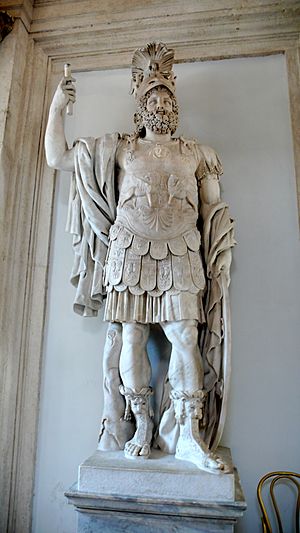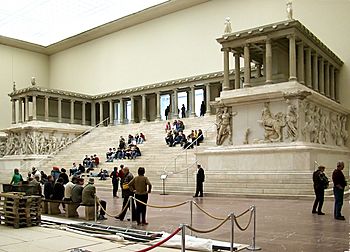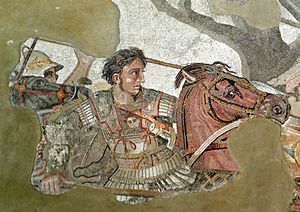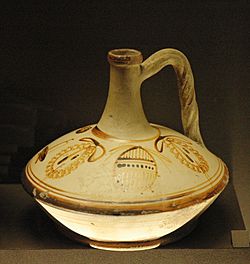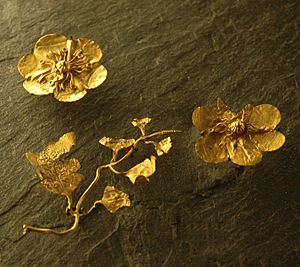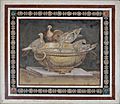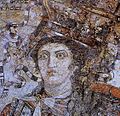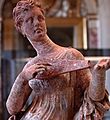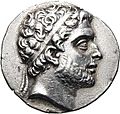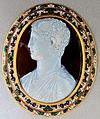Hellenistic art facts for kids
Hellenistic art was made in ancient Greece and nearby areas from about 323 BC to 31 BC. This period started after the death of Alexander the Great. For a long time, some people thought the art from this time was not as good as older Greek art. But many amazing artworks come from the Hellenistic period. Famous sculptures like the Laocoön group, the Venus de Milo, and the Winged Victory of Samothrace are all from this era.
Today, experts have studied more about Hellenistic art. They have found many beautiful pieces in places like Vergina. Now, most people agree that Hellenistic art is truly wonderful and important.
Contents
Amazing Architecture of the Hellenistic Age
After Alexander the Great died, his huge empire was split into smaller kingdoms. Each kingdom had its own ruling family. For example, the Ptolemies ruled Egypt. The Seleucids ruled Mesopotamia. The Attalids ruled Pergamon.
These new rulers spent money on art in a different way than the older Greek city-states. They built huge cities and large groups of buildings. This was a new style for Greece. Instead of changing the natural land, they made buildings that fit perfectly with the landscape. They also built many places for fun, like theatres and walking paths. These Hellenistic kingdoms had lots of empty land to build big new cities. Some of these cities were Antioch, Pergamon, and Seleucia on the Tigris River.
Pergamon: A City Built into Nature
Pergamon is a great example of Hellenistic architecture. It started as a simple fortress on a very large rock called the Acropolis. Different kings of Pergamon kept adding to it. They created a giant group of buildings. These buildings spread out from the Acropolis, following the natural shape of the land.
The agora (a public meeting place) was at the lowest level. It had covered walkways with stoai (tall stone columns holding up the roof). A main street started at the agora and went all the way through the Acropolis. On the east and top of the rock were buildings for leaders and soldiers. On the west side, in the middle, were religious buildings. One of the most famous is the Pergamon Altar. It is known for its beautiful sculptures of gods and giants. There was also a very big theatre with seats built into the hillside. It could hold almost 10,000 people!
Giant Temples and Grand Designs
During this time, people loved to build very big things. The second temple of Apollo at Didyma is an example. It was about 20 kilometers from Miletus. The design was made around 300 BC, but it was never fully finished. They kept building it until after 100 AD.
The special part of the temple, called the sanctuary, was one of the largest ever built near the Mediterranean Sea. Inside a huge room, the cella had two rows of columns. These columns were the Ionic kind, almost 20 meters tall. They had very detailed stone art on their bases and tops.
Expressive Sculpture of the Hellenistic Period
Hellenistic sculptures often showed strong feelings. They could show suffering, people sleeping, or old age.
Gauls and Giants in Stone
King Attalus I of Pergamon won a big battle against the Gauls. To celebrate, he had two sets of sculptures made. The first set was placed on the Acropolis of Pergamon. It included the famous Ludovisi Gaul, a sculpture of a dying warrior. The second set was given to Athens. It had small bronze statues of Greeks, Amazons, gods, giants, Persians, and Gauls.
The Dying Gaul was so popular that many copies were made by the Romans. These sculptures showed strong emotions and detailed features, like bushy hair and mustaches. The movements were often very powerful. This style is typical of Pergamon art.
These features were taken to an even higher level on the Pergamon Altar. This huge altar was decorated with a long sculpture called a gigantomachy. It was 110 meters long! It showed a battle between the Olympians (gods) and the Giants. Many Giants were shown turning into wild animals like snakes or lions. Their mother, Gaia, watched them suffer in pain.
Art for Private Homes
Another new idea in Hellenistic sculpture was making art for private homes. Older public art styles were used for decoration. This idea of looking back at older styles also appeared in pottery. Portraits of people started to look more natural, influenced by Roman art.
Amazing Paintings and Mosaics
Not many ancient Greek wall paintings have lasted until today. However, we can see Hellenistic influences in Roman frescoes, especially those found in Pompeii or Herculaneum. Some mosaics give us a good idea of the "grand paintings" of this time. These mosaics were often copies of famous frescoes.
The Alexander Mosaic
A great example is the Alexander Mosaic. It shows the young conqueror Alexander the Great fighting against King Darius III at the Battle of Issus. This mosaic decorated a wall in the House of the Faun in Pompeii. Many believe it is a copy of a painting described by Pliny the Elder. That painting was made by Philoxenus of Eretria for King Cassander of Macedon around the end of the 4th century BC. The mosaic lets us see the amazing colors, the way the picture is put together with turning movements, and the strong expressions on the faces.
Discoveries in Tombs
Recent discoveries have shown us original Hellenistic paintings. For example, in the cemetery of Pagasae (near modern Volos) and at Vergina (in 1987), archaeologists found some amazing works. The tomb believed to be that of Philip II had a large frieze (a long band of sculpture or painting) showing a royal lion hunt. It is special because of how it is composed, how the figures are placed, and how real the nature looks.
The Rise of Mosaics
The Hellenistic period was also when mosaics became very popular. Sosos of Pergamon was a famous mosaic artist in the 2nd century BC. He was known for his love of trompe l'oeil (optical illusions) and how he used the mosaic pieces.
Two works are believed to be his:
- The "Unswept Floor" in the Vatican museum. It shows the leftovers of a meal, like fish bones and empty shells, making it look like they are scattered on the floor.
- The "Dove Basin" at the Capitoline Museum. This mosaic shows four doves on the edge of a basin filled with water. One dove is drinking, while the others rest. The artist perfectly captured the reflections and shadows in the water.
Unique Ceramics and Vases
During the Hellenistic period, painting on vases became less common. Most vases were black and shiny, looking like they were varnished. They had simple designs of flowers or ribbons. This was also when vases with raised designs appeared. These probably copied vases made of valuable metals. Sometimes, wreaths were added in relief to the vase. Other times, vases had raised lines or grooves. More complex raised designs with animals or mythical creatures were also made. The shapes of the vases were also inspired by metal containers. For example, the lagynos (shown here) was a wine jar typical of this time.
Colorful but Fragile Vases
At the same time, some artists still made colorful vases with pictures. They tried to use more colors than before. However, these new colors were more delicate and could not handle heat well. So, the painting was done after the vase was fired, which was different from the old way. Because the colors were fragile, these vases were not used often. They were mostly made for funerals.
The best examples of this style come from Centuripe in Sicily. A workshop there was active until the 3rd century BC. These vases often had a pink base. The figures, usually women, wore colorful clothes like blue-violet chitons and yellow himations. The style reminds us of paintings found in Pompeii. It was more like the grand paintings of the time than the older red-figure pottery.
Smaller but Important Arts
Metal Art and Giant Statues
New ways of casting bronze allowed Greeks to create huge works. A famous example was the Colossus of Rhodes, a giant statue 32 meters tall! Sadly, most large bronze statues were melted down for their metal. So, only smaller metal objects still exist today. Luckily, during Hellenistic Greece, there was plenty of metal after the conquests in the East.
Artists also became very skilled at working with metal vases. Beautifully sculpted gold vases were found at Panagyurishte in Bulgaria. One amphora (a type of vase) had two rearing centaurs as handles. In Derveni, near Salonica, a tomb held a large bronze krater (a mixing bowl) from around 320 BC. It weighed 40 kilograms!
This Derveni krater was decorated with a 32-centimeter-tall band of figures. It showed Dionysus, the god of wine, with Ariadne and his followers, the satyrs and maenads. The top of the vase had decorative patterns. Four satyrs sat casually on the shoulders of the vase.
Jewelry making also changed. Jewelers became experts at tiny details and fine wire work. Funeral wreaths, for example, had very realistic leaves or stalks of wheat made of gold. This was also a time when setting precious stones into jewelry became popular.
Small statues, called figurines, were also fashionable. They showed gods and goddesses, as well as everyday people. The theme of the "negro" (Black people) became popular, especially in Ptolemaic Egypt. These small statues of Black teenagers were popular even into the Roman period. Sometimes, these small figures were copies of larger, famous sculptures. Many small copies of the Tyche (good luck goddess) of Antioch were made. The original statue was from the early 3rd century BC.
Terra Cotta Figurines
Before the Hellenistic period, Greek terracotta figurines were mostly used for religious purposes. But in Hellenistic Greece, they were more often used for funerals or just for decoration. Better molding techniques allowed artists to create very detailed miniature statues.
In Tanagra, in Boeotia, the famous figurines were made. They were full of bright colors and usually showed elegant women in charming scenes. In Smyrna, in Asia Minor, two main styles were popular. First, there were copies of famous large sculptures, like the Farnese Hercules made of gilt (gold-covered) terra cotta.
In a very different style, there were "grotesques." These were figures that looked very different from the usual "Greek beauty." The koroplathos (figurine maker) made figures with deformed bodies or strange poses. These included hunchbacks, epileptics, hydrocephalics, and obese women. People wonder if these were medical models, since Smyrna was known for its medical school. Or, they might have just been funny caricatures meant to make people laugh. "Grotesques" were also common in Tarsus and Alexandria.
Glass Art and Engraved Gems
During the Hellenistic period, Greeks learned a new technique: glass blowing. Before this, they only knew how to mold glass. Glass blowing allowed for many new shapes. Glass art became especially popular in Italy. Molded glass was still used, especially for making intaglio jewelry (designs cut into the surface).
The art of engraving on gems did not change much. It mostly produced many similar items without much new design. However, the cameo appeared during this time. A cameo is a carving made in relief on a stone that has several colored layers. This allows the artist to create a raised image using the different colors of the stone. After carving, the cameo was often set into a pendant or a ring. The Hellenistic period produced some masterpieces, like the Gonzaga cameo, which is now in the Hermitage Museum.
Related Pages
Images for kids
-
A bronze portrait with inlaid eyes, found in Lake Palestra on the Island of Delos.
-
A reconstruction of the Blinding of Polyphemus from the Sperlonga sculptures.
-
The Nile mosaic of Palestrina, showing Ptolemaic Egypt.
-
A detail of the Alexander Mosaic, showing Alexander the Great.
-
A West Slope Ware kantharos vase.
-
A tomb monument of a dying Adonis, made of colorful terracotta.
-
A marble relief fragment showing a Kore.
-
A bust of Ptolemy I Soter wearing a diadem, a symbol of kingship.
-
A mosaic showing the Abduction of Helen of Troy by Theseus.
-
A Macedonian mosaic showing the abduction of Persephone by Pluto.
-
A stele showing a Ptolemaic thureophoros soldier.
-
A detail of a Hellenistic mosaic floor panel showing an Alexandrine parakeet.
-
The Sampul tapestry showing a possible Greek soldier and a centaur.
-
A Ptolemaic mosaic of a dog and an askos wine vessel.
-
A mosaic of the Ptolemaic Queen Berenice II.
-
A Krater with relief decorations.
-
A sphageion vase with gorgoneions.
-
An askos in the shape of a woman's head.
-
An ancient Greek terracotta head of a young man.
-
The golden larnax (chest) of Philip II of Macedon.
-
The golden wreath of Philip II of Macedon.
-
The Gonzaga Cameo.
-
A gold ring with a portrait in garnet.
-
Philip V of Macedon wearing a royal diadem.
-
A Roman copy of a Hellenistic bust of Seleucus I Nicator.
-
A Roman copy of a Hellenistic original depicting Homer.
-
The Tyche of Antioch.
-
A marble statue of Demosthenes.
See also
 In Spanish: Arte helenístico para niños
In Spanish: Arte helenístico para niños


